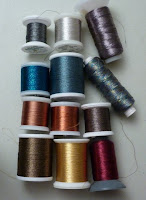I had some difficulty in finding an example of Indian embroidery to study "in the flesh" that was authentic, so I resorted to the internet and found some good closeups of embroidered fabric. That along with a few reference books ("Embroidered Textiles" by Sheila Payne and "Indian Embroidery" by Rosemary Crill) from the library gave me a good idea of the stitches involved.
 |
| 5.1 |
My study embroidery is in the centre of this photo (5.1) and my drawings in black pen and white ink are scattered around. The colour was added generally by pigment pencils and washed over with water.
 |
| 5.2 |
In 5.2 I drew with a kebab stick dipped in bleach on black handmade paper (left). I had this paper left over from the Certificate studies when I had dyed the pulp with black procion dye. The image I was recreating (centre) was drawn in Markal oil sticks as a resist over a texture plate (right) then washed with brusho solution.
 |
| 5.3 |
In 5.3 I used the Markal sticks over the same plate on black tissue paper. I felt the rubbing gave patterns very similar to the original white chain stitch on black.
 |
| 5.4 |
5.4 shows a few relief patterns that I made using translucent liquid polymer clay (TLPC) on cardboard. This polymer clay is intended to allow patterns / pictures to adhere permanently onto polymer clay for jewellery pieces or other motifs, but I've never used it for that purpose. I produce weblike structures that can stand on their own for 3D work or attach onto hangings etc. If spread thinly enough the sheet is flexible, can be cut easily, stitched through and even better the tranlucent base can be coloured with pigments before curing or painted afterwards. Oh, I could go on for ages - love the stuff. I taught a workshop last month and the TLPC kind of took over for some ladies!
Anyway, here on cardboard it's fixed itself, won't peel off and so produces a useful stamp / relief block.
The rubbings in 5.4 show that a constant line is not produced but I like that incomplete look to the patterns.
 |
| 5.5 |
5.5 shows three relief blocks made with blind cord on lino tiles. The tiles are great because the stamp has a bit of flexibility (a bit like
monoprinting with Ruth on flexible acetate - what a revelation that was for me!).
The rubbings are made using pastels or wax crayons on tissue paper or thin paper bags.
 |
| 5.6 |
5.6 - The block (the green one in the bottom right of photograph) was made from an easy carve block. The other pattern is cut on the other side of the block. The prints are made using (clockwise from bottom right) rubbings on black tissue paper with white and gold Markal and white wax crayon, monoprints with green acrylic on paper, and rubbings on inked paper with Markal.
 |
| 5.7 |
5.7 I had a go at replicating some of the designs in my study shi-sha mirrored embroidery. The background fabric was dyed homespun and a little chlorine was used to trace the outline shapes for embroidery.
The sample piece includes normal chain stitch, open chain stitch, back stitch, buttonhole stitch, normal herringbone and Indian (double) herringbone stitch, roman stitch over laidwork and couching in addition to shisha stitch around the mirrors. Not so sure I like the colour scheme but it's true to the original.








































.jpg)











